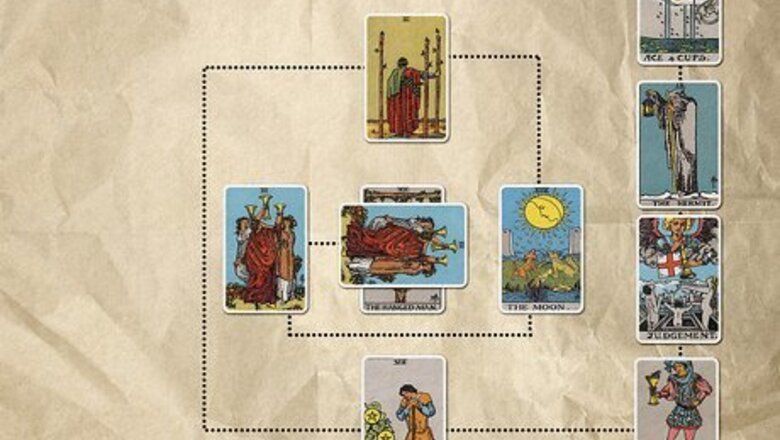
views
- The 1st card you draw in a Celtic Cross spread signifies you or the situation at hand, and the 2nd card represents your most pressing challenges or setbacks.
- The 3rd and 4th cards represent past and future events, respectively, while the 5th card represents your goals and the 6th card symbolizes your subconscious.
- The 7th through 10th cards provide a broader context to your situation and touch on areas like your influences, hopes, and fears.
How to Read a Celtic Cross

Examine the entire Celtic Cross for a general overview of the situation. Before diving into each specific portion of the spread, look at the whole picture for emerging patterns and themes. Are there cards from similar suits? Do any of your cards share common images? Write down everything you notice, and remember there are no wrong answers! Using the “How can I further my career?” spread as an example, you may notice a lot of these cards depict characters by themselves: The Hanged Man, The Hermit, King of Cups, and Eight of Swords. This could mean the solution to your problem will need to be solved by you alone, without the help of others. Love tarot? Take this quiz to discover which tarot card truly matches your personality.

Examine the central axis (cards 1-6). Once you’ve done a general overview of your Celtic Cross, break it up into 2 parts. Cards 1-6 are “the central cross” or “axis,” which represents your (the querent’s) life and experiences. Use these to get a more in-depth glimpse at your current environment at the time of the reading. Then, examine how the cards relate to the question you asked. For example, if you drew The Hanged Man as your 1st card with different suits across the rest of the axis (Seven of Pentacles, Eight of Swords, Three of Cups), this could suggest that, though you feel helpless, your emotional, ideological, and material well-being are all balanced nicely.

Analyze the staff (cards 7-10). While the axis is focused entirely on you, the final 4 cards (or staff) symbolize the relationship between you and your environment. The staff shows what’s happening beyond your immediate worldview. Look for themes that emerge in this block of 4 and compare it to the central cross. For example, using the previous spread, you may notice the staff has a lot of cup cards (which represent emotions and inner journeys), compared to the more action-oriented swords, wands, and pentacles in the central axis. This could mean that, though your day-to-day struggles are very work-based, your overall journey is more emotional.
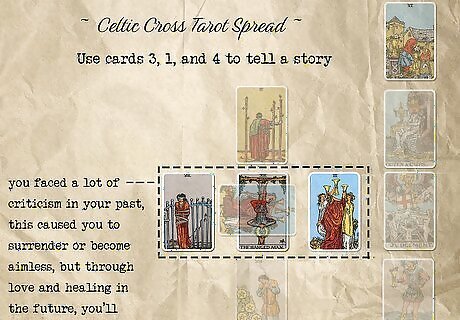
Use cards 3, 1, and 4 to tell a story. Card 3 (the past), card 1 (you/the present), and Card 4 (the future) function as a sort of chronological timeline. Look for bridges in how each of these cards might connect and try to come up with current situations that may cause one card to lead to another. For example, if you pull the cards: Eight of Swords Past, Hanged Man Present, and Three of Cups Future, the story here might be: you faced a lot of criticism in your past, this caused you to surrender or become aimless, but through love and healing in the future, you’ll find your power again.

Interpret cards 5, 6, and 1 as id, ego, and superego. Think of these 3 cards like an iceberg. Card 6, at the bottom, is what’s bubbling beneath the surface: the ideas you don’t want to talk about. Card 5, at the top, is what you’re striving towards but doesn’t exist yet. You (card 1) are the translator, trying to connect both of these to live your best life. Figure out the core differences between 5 and 6. Then, try to come up with ways you can make them function in unison. For example, if you drew Card 1 Hanged Man (self), Card 5 Three of Wands (superego), and Card 6 The Moon (id), this could mean how your fear of confrontation (Moon) has caused you to surrender. Therefore, you look to travel (Three of Wands) as an escape from tough conversations. However, you must surrender (Hanged Man) to that fear to move forward.
Looking for Patterns

Pay attention to the arcana of your cards. Two of the most common patterns to identify are major and minor arcana. The major arcana (numbered characters) are at the beginning of the deck. The presence of these cards signifies that this situation will have a large spiritual impact on your life. Meanwhile, the minor arcana (cups, swords, wands, pentacles) are more situational and less intense. Using the “How can I further my career?” example, there were a lot of minor arcana cards, which could mean your job isn’t as important to your overall journey as you might think.
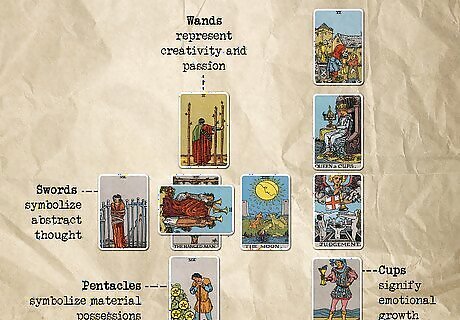
Look at the suit of each of your cards. If you have a lot of minor arcana cards, pay attention to which suit these cards come from. Are they wands, swords, cups, or pentacles? If you have one suit that’s much more present than the others, it means the spiritual meaning of that suit will factor in heavily to solving your current problem. The meanings of each suit are as follows: Swords tend to symbolize abstract thought. Wands represent creativity and passion. Cups signify emotional growth. Pentacles symbolize material possessions.
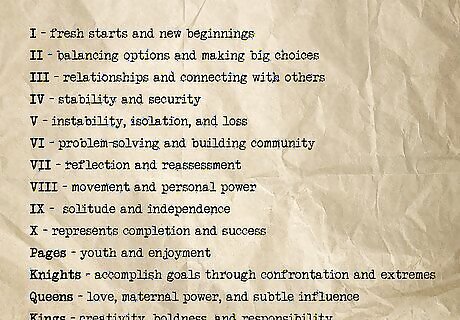
Analyze the numbers of your cards. Almost every tarot card has a number. The major arcana cards are labeled 0-21 while the minor arcana has 10 of each suit (along with 4 court cards: page, knight, queen, and king). Each of these numbers carries significant metaphysical meaning, especially when it appears more than once. For example: One represents fresh starts and new beginnings. Two stands for balancing options and making big choices. Three symbolizes relationships and connecting with others. Four represents stability and security. Five signifies instability, isolation, and loss. Six is about problem-solving and building community. Seven represents reflection and reassessment. Eight stands for movement and personal power. Nine is all about solitude and independence. Ten represents completion and success. Pages signify youth and enjoyment. Knights accomplish goals through confrontation and extremes. Queens represent love, maternal power, and subtle influence. Kings symbolize creativity, boldness, and responsibility. The remaining major arcana cards (11-21) each have their own meaning outside of numerology.
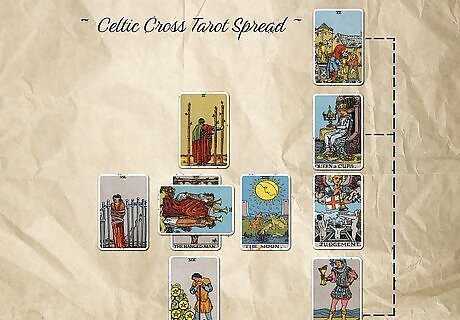
Pay attention to the common pairs in each spread. Look for similarities between any pair of 2 cards. Do you have cards of the same number? The same suit? Do certain cards represent similar things? Vice versa, if 2 cards have directly opposed meanings, try to think of reasons that may be causing this contrast. Using a different example from the “How can I further my career?” spread, if you drew Temperance (restraint/patience/heaven) as Card 3 (past) and the Devil (indulgence/confrontation/hell) as Card 4 (future), figure out what you (the present) may be doing or thinking to cause such a switch in your life.
Common Card Pairings

What You Want to Happen (Card 5) vs What Will Happen (Card 10) Examine the symbolism of your final card and work backward. Think of how the meaning of your 10th card will manifest in real-life situations. Then, try to apply the goals of your 5th card to those situations to create an outcome you’re happy with. Using the “How do I further my career” spread as an example, you might notice how card 10 (Ace of Cups) is all about new beginnings. Knowing you’ll likely be starting a new adventure soon, you could apply card 5 (Three of Wands)’s theme of travel to determine that you should go somewhere new rather than familiar.
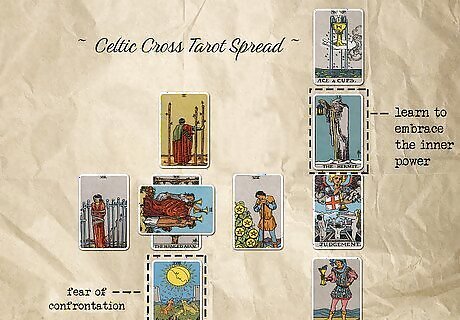
Repressed Feelings (Card 6) vs Hopes & Fears (Card 9) Card 9 offers a wider context to Card 6 and vice versa. Think of card 9 as the manifestation of card 6’s worst-case scenario. Reflect on how card 6 could morph into card 9. Then, try to find some solutions to prevent this from happening. For example, if your fear of confrontation in Card 6 The Moon causes you to become too docile, it could cause you to face the loneliness and isolation of Card 9 The Hermit. However, if you stand up for yourself, you’ll learn to embrace the inner power that comes from the Hermit’s solitude.
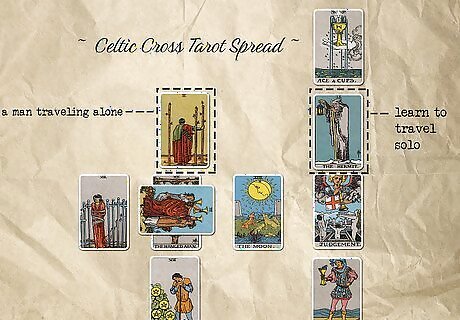
Specific Hopes (Card 5) vs General Hopes (Card 9) Card 9 can offer some perspective on whether or not achieving Card 5 is unique to the situation at hand, or if these goals can lead to long-term wish fulfillment. You can also think of card 5 vs 9 as “want vs need.” Card 5 may give you what you want now, but card 9 will better your life in the long term. See if there are any clear correlations between the two and, if there aren’t, try to reason what the core differences are. For example, the Three of Wands (card 5) depicts a man traveling alone. This could match the liberating solitude of The Hermit (card 9)’s solo travels.

Future Events (Card 4) VS Likely Outcome (Card 10) Despite being a part of the staff, card 10 is fairly specific. It pinpoints the most likely scenario you’re going to encounter. Card 4, on the other hand, offers a series of possibilities that may or not be related to the situation at hand. Examine what parts from card 4 could lead to card 10 and if there are any common threads between the 2. For example, if you drew Card 4 Three of Cups and Card 10 Ace of Cups, this shows that your future journey is emotional (since both cards are cups). In addition, the healing and relationship-building you’ll encounter in card 4 can lead to the love and opportunity presented by card 10.
How to Create a Celtic Cross

Card 1: The Present Lay your 1st card out in the center of your spread to represent you or the situation at hand. The 1st card you draw in the Celtic Cross tarot spread is the most powerful. It covers you, the situation you’re dealing with, or both. It might help to interpret the 1st card before drawing any others so you have a clear picture of what this reading will be about. It can help to ask your tarot cards a question before drawing your first card. Try to keep questions open-ended (no concrete, obvious answers) and focused on yourself. For example, if you asked “How can I further my career?” and you drew The Hanged Man (which represents surrendering and letting go), this could represent how you’re feeling aimless at your current job or how the overall lesson of your reading is to let go and stay open.
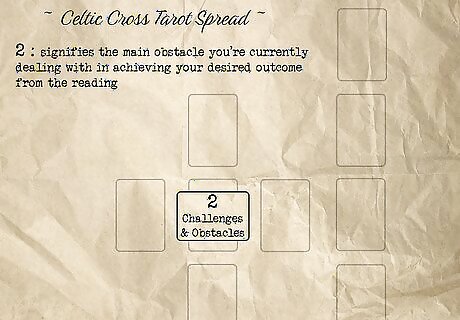
Card 2: Challenges & Obstacles Place your 2nd card across your 1st card to represent challenges. The 1st and 2nd cards make up the central cross of the Celtic Cross. Laid horizontally across your vertical 1st card, the 2nd card signifies the main obstacle you’re currently dealing with in achieving your desired outcome from the reading. Using the “How can I further my career?” example, you probably have a goal of getting your dream job or a promotion at your current workplace. Therefore, if you drew the Seven of Pentacles (which represents long-term investments), this could signify that your main difficulty right now is: your dream job providing satisfaction but not long-term finances, your current job being too gig-based/day-to-day, or something in between.
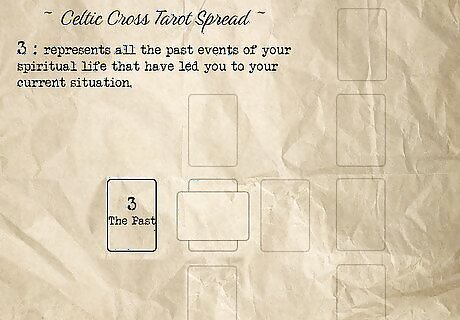
Card 3: The Past Place the card to the left side of the 1st card. Card 3 represents all the past events of your spiritual life that have led you to your current situation. These events can be major or minor. Every 3rd card’s meaning is different and will ultimately be decided by your own interpretation. For example, if you drew an Eight of Swords (which stands for criticism and victim mentality) for the question “How can I further my career?” this could mean you lacked confidence and self-esteem in your past, which has caused you to undervalue yourself and the work you do.

Card 4: The Future Position your 4th card to the right of the 1st card to represent upcoming events. Now that you’ve determined the past for your situation, it’s time to look to what’s to come. The 4th card provides predictions of things that may come to pass in the next few weeks, months, or years (depending on how broad you want to be). While these events can be directly related to your 1st and 3rd cards, they don’t have to be. For example, if you drew a Three of Cups as your 4th card (which often stands for connection, loved ones, and celebration) for a career reading, you may read this as a sign of an upcoming work party where you can network, how now isn’t the time to focus on work but to focus on friends, or something entirely different depending on the context of the other cards.

Card 5: Goals Set your 5th card above your 1st card to represent your aspirations for this particular reading. There’s a reason the 5th card sits above the “you” card in a Celtic Cross. It stands for the dreams and desires you consciously wish for or hold above you. For example if you drew the Three of Wands (progress/expansion/travel) for the question “How can I further my career?” this could signify how you want to move forward in your current job more than anything. You may even want to work overseas.

Card 6: Repressed Feelings Lay your 6th card below your 1st card to represent your subconscious. While the 5th card controls all your conscious desires, the 6th card is the exact opposite. It signifies all the ideas and emotions you bury deep down. It usually provides an “aha” moment, helping you recognize things you’re afraid to admit or didn’t know you needed. For example, if you drew The Moon (which represents illusions, intuition, and crisis), this card could be telling you that you’re afraid of trusting your intuition when it comes to career goals and job opportunities.

Card 7: General Wisdom & Advice Position your 7th card to the bottom right of your 4th card for advice. The 7th card of the Celtic Cross is the beginning of a whole new section: the staff. The staff is meant to target your tarot question in a wider context, and this card offers general guidance and wisdom from a broader perspective. For example, if you drew the Six of Cups (which represents childhood and reconciliation) as your 7th card, the Celtic Cross may be telling you to embrace your inner child and get in touch with old friends. It may not directly influence your career, but it will help you live a more enriched life overall.

Card 8: External Influences The 8th card in a Celtic Cross can be both comforting and frustrating. It symbolizes the factors that are completely outside of your control. While this can help you let go, it also means there’s not a whole lot you can do about your current circumstances. It’s placed above the 7th card to showcase that, while you can try to use logic to control your situation, there are higher, more powerful forces at play. For example, if you drew the King of Cups (which stands for emotional maturity/diplomacy) after the Six of Cups, this could be telling you that, despite your best efforts to embrace inner childhood, growing up and responsibilities at work are inevitable.
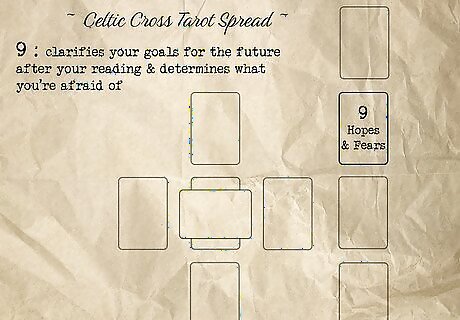
Card 9: Hopes & Fears The 9th card begins the final portion of your Celtic Cross. Placed directly above the 8th card, it’s meant to clarify your goals for the future after your reading and determine what you’re afraid of. While the 5th card is meant to represent your goals for the situation at hand, the 9th symbolizes your general hopes and aspirations. It can show both the best and worst possible outcomes. For example, if you drew The Hermit (which stands for inner healing, reclusion, and self-exploration) under the question “How can I further my career?” it might be telling you that, though you want to succeed at your job, your true goal (even though it’s scary) is discovering who you are, regardless of your occupation.
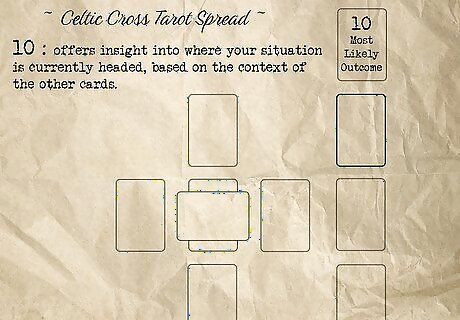
Card 10: Most Likely Outcome The 10th card is the most tangible card in a Celtic Cross spread. Placed directly above the 9th card, it’s meant to offer insight into where your situation is currently headed, based on the context of the other cards. However, nothing is set in stone. The 10th card only assumes what will happen based on where you are currently. You can absolutely change your fate if you don’t like your 10th card. For example, to conclude a reading on “How can I further my career?” suppose you drew the Ace of Cups (love, new beginnings) as your 10th card. This could mean that, though there may be a major change ahead, you’ll love your new job/life and the opportunity will excite you regardless.




















Comments
0 comment